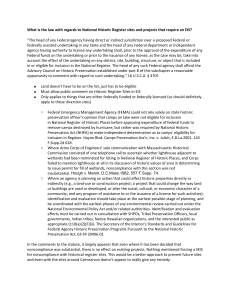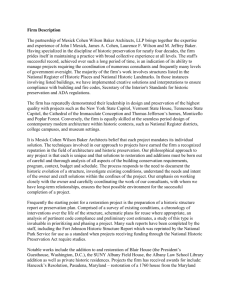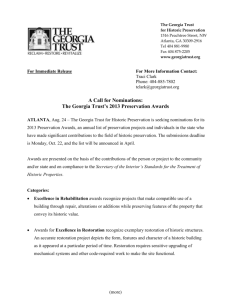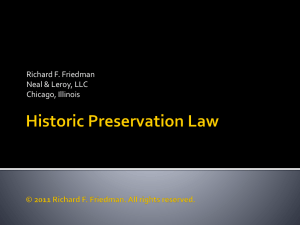HISTORIC PROTECTION
advertisement
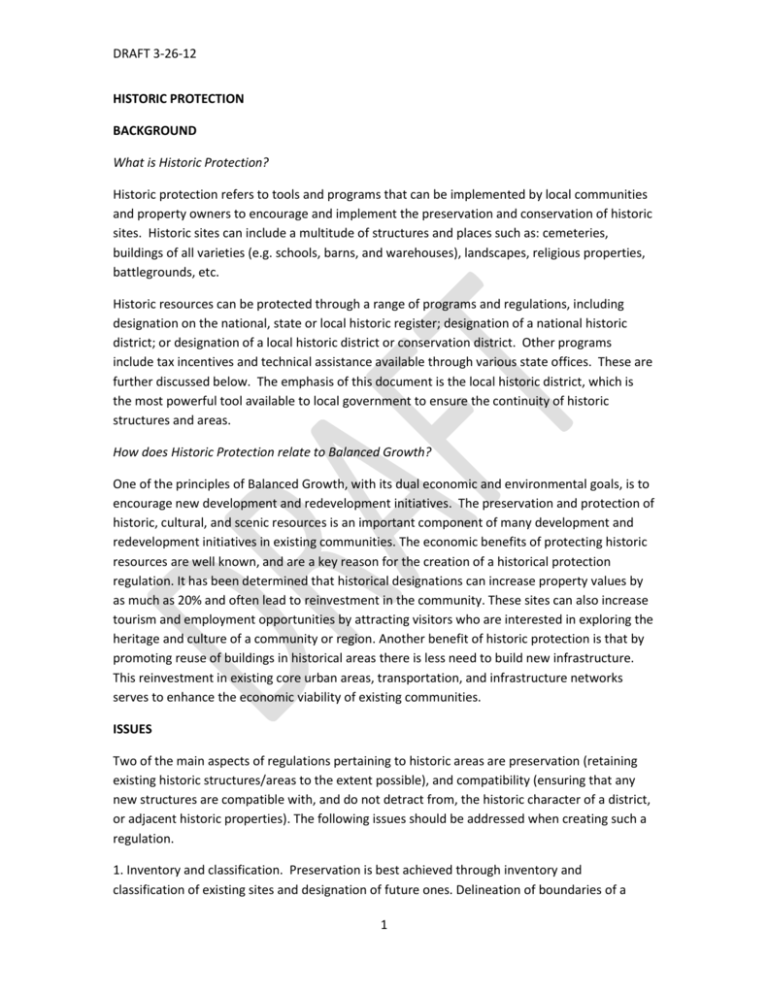
DRAFT 3-26-12 HISTORIC PROTECTION BACKGROUND What is Historic Protection? Historic protection refers to tools and programs that can be implemented by local communities and property owners to encourage and implement the preservation and conservation of historic sites. Historic sites can include a multitude of structures and places such as: cemeteries, buildings of all varieties (e.g. schools, barns, and warehouses), landscapes, religious properties, battlegrounds, etc. Historic resources can be protected through a range of programs and regulations, including designation on the national, state or local historic register; designation of a national historic district; or designation of a local historic district or conservation district. Other programs include tax incentives and technical assistance available through various state offices. These are further discussed below. The emphasis of this document is the local historic district, which is the most powerful tool available to local government to ensure the continuity of historic structures and areas. How does Historic Protection relate to Balanced Growth? One of the principles of Balanced Growth, with its dual economic and environmental goals, is to encourage new development and redevelopment initiatives. The preservation and protection of historic, cultural, and scenic resources is an important component of many development and redevelopment initiatives in existing communities. The economic benefits of protecting historic resources are well known, and are a key reason for the creation of a historical protection regulation. It has been determined that historical designations can increase property values by as much as 20% and often lead to reinvestment in the community. These sites can also increase tourism and employment opportunities by attracting visitors who are interested in exploring the heritage and culture of a community or region. Another benefit of historic protection is that by promoting reuse of buildings in historical areas there is less need to build new infrastructure. This reinvestment in existing core urban areas, transportation, and infrastructure networks serves to enhance the economic viability of existing communities. ISSUES Two of the main aspects of regulations pertaining to historic areas are preservation (retaining existing historic structures/areas to the extent possible), and compatibility (ensuring that any new structures are compatible with, and do not detract from, the historic character of a district, or adjacent historic properties). The following issues should be addressed when creating such a regulation. 1. Inventory and classification. Preservation is best achieved through inventory and classification of existing sites and designation of future ones. Delineation of boundaries of a 1 DRAFT 3-26-12 potential historic district is an important component of this process. Boundaries should include an adequate buffer area surrounding the site to help protect against development activities that may not be compatible with the existing historical use. 2. Local regulation options. Options for local government historic protection include adoption of a Local Historic District code, and/or a Conservation District Code. The Historic District code establishes criteria for any changes made to locally significant historic buildings (they need not be state or nationally registered). Approval must be obtained from the community for alteration and/or demolition of any structure protected by the code. Additional provisions can include design guidelines for new construction within the district to ensure that it is compatible with the district character. A Conservation District code is less stringent, but sets guidelines to ensure that any development changes in a designated area are compatible with the overall character of the district. Demolition and alteration of structures are typically not challenged as long as the new construction meets overall character guidelines. 3. Designation on a national or state register. Contrary to common understanding, listing of any structure on the State or National Register of Historic Places, and/or identification of a neighborhood as a National Historic District does not provide the community with control over demolition and alteration of structures. The benefits that come with these designations are limited to tax benefits for the property owner, which can be substantial, particularly for commercial owners seeking to do restoration work. There are also market advantages for tourism that come with public awareness of state and nationally designated sites. 4. Design Guidelines. Design guidelines should be established to preserve the character of the historic site or area. These guidelines should be professionally prepared, and help to establish criteria for review and approval of proposed new development and alterations to existing sites. For Certified Local Governments (see below), grant funds are available to help with the cost of developing design guidelines. 5. Historic Review Boards. For Historic District and Conservation District codes, a commission or other body is typically needed to develop review criteria and oversee the application process. This body may also act as an enforcer of penalties and to evaluate special cases such as hardship, variances, phasing and demolition by neglect. Another job of the commission is to deal with public relations and education for historic sites; the commission may also choose to act in the role of a land bank. 7. Economic incentive programs. In addition to local historic districts, there are several economic incentive programs for historic preservation. These incentives are usually in the form of property tax reductions, reductions in fees, and grants for rehabilitation. From those communities that are starting their first historic preservation initiatives to those that have wellestablished programs, each community that is involved may need help in beginning and completing projects. This usually means a need for funding. To create a stream of federal funding through the state to local governments, your local government can enroll to be a 2 DRAFT 3-26-12 “Certified Local Government” which enlists them as an eligible entity for grants, technical assistance, and other support. This program is provided by the Ohio Historic Preservation Office. Tax credits are provided by the Ohio Historic Preservation Tax Credit Program that is run by the Department of Development. The tax credits apply to rehabilitation of historic buildings. The non-governmental owner of a building can be eligible if the work is consistent with standards for rehabilitation (set by the U.S. Secretary of the Interior), and if the tax credit is a major factor in rehabilitating the building or increasing the level of investment. If received, then the incentives would provide 25% of “Qualified Rehabilitation Expenditures” (QREs) with a cap of $5 million. These expenditures can include both construction and design/engineering costs. There is also a Federal Historic Preservation Tax Credit program which provides 20% of QREs. When used together, the state and federal tax credits can amount to 45% of QREs. It is recommended that economic incentives be addressed and encouraged in any local preservation plan. Giving a building an “historic” designation does not limit all of its uses. Historic buildings can be used for recreational purposes, offices, government centers or businesses. In some states, government offices are encouraged to move into historic buildings as a means of preservation. When these buildings are vacant, residential uses can also be encouraged. The Ohio Heritage Main Street program, administered by Heritage Ohio, provides assistance to member communities in revitalizing historic or traditional commercial areas, enhancing community character and spurring economic activity. The program provides technical assistance, training, mentoring, and funding for Main Street efforts to eligible communities. For more information see the resources. 8. Public education and involvement. While the economic benefits of historic preservation are well documented, they are not well known or accepted by the public. Property owners especially can be skeptical about the long term benefits of implementing a historic preservation regulation. Any effort to establish a historic district or other local program should involve an extensive education and support-building effort with the community, including residents, families, businesses, and institutions. 9. Zoning Standards. There are other ways to protect or enhance the historical character of buildings within a community. If a community does not have the capacity or support to create historical districts or start an historical preservation program, they may make changes to architectural standards in the zoning regulations for certain districts. This allows a community to create or preserve character on a more basic scale, but without the benefits of tax credits and other related funding for historic buildings. 10. Façade easements. A community could also use façade easements for selected buildings if owners are willing to agree. These easements preserve historical or important aspects of the exterior of a building and may be applied to other parts on the outside of the 3 DRAFT 3-26-12 building. The easement is typically held by the community, or a local nonprofit organization, such as a historical association, that is formed for a recognized public purpose. A typical easement will be negotiated individually to meet the needs of the easement holder and the property owner. RECOMMENDATIONS 1. It is recommended that communities address historic resources through comprehensive planning following an inventory, evaluation, and prioritization of historic sites. Implementation may include designation of significant sites or boundaries for historic and conservation districts. 2. Establish a community education and outreach program to provide local residents, property owners and businesses with information about the economic benefits of historic protection, as well as information about the various tax benefits and funding programs available to support historic preservation. 3. Zoning regulations designed to preserve historic sites should address the delineation of historical district boundaries, design guidelines, variance procedures, and violation guidelines. 4. The State of Ohio supports strong “home rule” standards that allow local governments, particularly municipalities, to create historic districts within their community. There are precedents for townships enacting local historic districts in Ohio; communities interested should consult their Solicitor for advice. 5. Communities adopting a Local Historic District should consider becoming a Certified Local Government through the Ohio Office of Historic Preservation which will make them eligible for benefits, training, and funding support for ongoing continuation of their Historic Preservation program. 6. Communities should also explore programs available through Heritage Ohio and the Ohio Department of Development that support historic preservation. EXAMPLE REGULATIONS FOR GUIDANCE Listed below is the example historic preservation model regulation for the State of Ohio, available through the Ohio Office of Historic Preservation. The OHP is also a good resource for examples of Conservation District models, lessons learned from other communities, and other examples of successful approaches to historic protection in Ohio communities. 4 DRAFT 3-26-12 The example regulations should never be adopted without careful local review to assure that they are adapted to fit the needs of the specific local government. They will need to be adapted for use by the specific type of local government: city, village, township, or county. The law director/ solicitor or county prosecutor should be consulted prior to adoption of any land use controls. Questions about the examples and recommendations can be directed to the Ohio Lake Erie Commission and/or the Ohio Water Resources Council. Ohio Historic Preservation Office, Model Ordinance http://www.ohiohistory.org/resource/histpres/toolbox/clg/clg-11.html RESOURCES The Community Planning Program, Tel: 216-687-5477, Web: http://urban.csuohio.edu/cpp/ Heritage Ohio Main Street Program http://www.heritageohio.org/main-street-program/ Ohio Historic Preservation Office http://www.ohiohistory.org/resource/histpres/# Ohio Historic Preservation Tax Credit Program Policies http://www.development.ohio.gov/Urban/ohptc/documents/OHPTC_Policies_Draft_2011.pdf Ohio Historic Preservation Tax Credit Program http://development.ohio.gov/Urban/OHPTC/ National Park Service – Tax Incentives for Preserving Historic Properties http://www.nps.gov/tps/tax-incentives.htm SIDEBAR The Village of Jefferson Historic District In 2006, the Village of Jefferson in Ashtabula County embarked on a plan to examine ways to balance the need to accommodate new business in their downtown, with an interest in preserving the Village’s heritage of historic homes and buildings. A citizens committee, working with the Village’s Mayor, Council, Planning Commission, Chamber of Commerce and historic society, led a process to evaluate the economic vitality and market for their downtown and compare the relative benefits of a local historic district with a conservation district, and other programs. The community chose to implement a local historic district, adopting a code in 2010. Recently, a Historic Review Board has been seated and the village has become a Certified Local Government, working with the Ohio Office of Historic Preservation to train their new board members and apply for 5 DRAFT 3-26-12 grants for assistance in evaluating historic properties. It is hoped that the downtown district and businesses will continue to thrive and that business and tourist opportunities will expand, with knowledge that the Village’s historic character will be preserved and enhanced into the future. (need to check credit for photo) Historic preservation is an important component of main street revitalization. (photo: K.Date) 6 DRAFT 3-26-12 Historic preservation contributes to rural character. (photo: K.Date) 7

